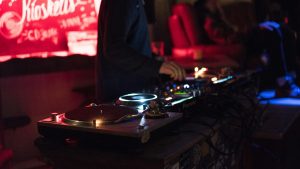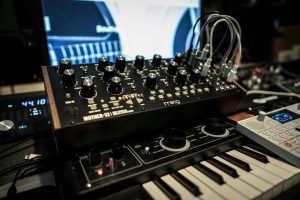
In a world dominated by digital innovation, a curious phenomenon has emerged: the resurgence of vintage analog technology in electronic music. While sleek software synthesizers and cutting-edge digital audio workstations (DAWs) have revolutionized music production, an increasing number of artists are turning to analog instruments, tape machines, and modular synthesizers to craft their soundscapes. This revival is not a rejection of modern advancements but a celebration of the unique warmth, imperfections, and tactile experiences that analog gear offers. It’s a movement shaped by nostalgia, artistry, and the quest for sonic authenticity.
The Unique Sound and Warmth of Analog Instruments
One of the most compelling reasons for the analog revival is the distinct sound that vintage instruments produce. Analog synthesizers, drum machines, and tape recorders are known for their organic warmth and rich tonal quality, characteristics that are often described as impossible to replicate fully in the digital domain.
Unlike digital systems, which rely on precise numerical data, analog equipment generates sound through continuous electrical signals. This creates subtle imperfections—quirks in pitch, tone, and dynamics—that give the sound a lifelike, human quality. For many electronic musicians, this imperfection is a feature, not a flaw. The unpredictable nuances of analog gear introduce a layer of unrepeatable magic to their recordings, resulting in tracks that feel alive and dynamic.
Classic analog synthesizers like the Minimoog, ARP 2600, and Roland Juno-60 have become sought-after treasures. Their warm, fat basslines and lush, evolving pads remain unmatched in character. These sounds evoke an emotional connection for both musicians and listeners, reminiscent of the golden eras of electronic music in the 1970s and 1980s. Additionally, tape machines and reel-to-reel recorders add a creamy saturation and gentle compression that modern digital systems struggle to replicate authentically.
As digital tools have improved over the years, they have ironically drawn more attention to the intangible charm of analog sound. The imperfections that once led to the abandonment of analog systems are now cherished for their ability to add depth, grit, and texture to a recording. This demand for warmth and personality in sound is a driving force behind the renewed popularity of analog instruments.
A Reaction to the Over-Precision of Digital Music
Another key factor in the analog resurgence is the growing frustration with the sterility and over-precision of digital music. DAWs like Ableton Live, Logic Pro, and FL Studio offer immense power and flexibility, enabling producers to tweak every aspect of a track down to the millisecond. However, this level of control often comes at the cost of spontaneity and soul. Perfectly quantized beats and pristine soundscapes can feel robotic and emotionless, lacking the imperfections that give music its humanity.

Analog gear offers a way to escape this rigidity. Instruments like modular synthesizers and analog drum machines encourage a more hands-on, experimental approach to music-making. Twisting knobs, patching cables, and physically interacting with the equipment create a visceral connection between the artist and their sound. Mistakes, happy accidents, and organic variations are embraced rather than edited out, leading to compositions that feel more authentic and emotionally engaging.
The analog workflow often forces musicians to slow down and think differently about their creative process. Unlike digital tools that encourage infinite undo options and endless layering, analog equipment requires decisiveness and commitment. Recording with a tape machine, for instance, means you have limited takes and must be more intentional about your choices. This limitation paradoxically fosters greater creativity, as artists are compelled to work within constraints and trust their instincts.
For many, returning to analog gear is an act of rebellion against the hyper-digitalization of modern music. It’s a way to reclaim the human touch in a field increasingly dominated by algorithms and automation. By embracing analog technology, electronic musicians can inject soul and individuality back into their productions, connecting with audiences on a deeper level.
Nostalgia and Cultural Reverence for Vintage Gear
Nostalgia plays a powerful role in the analog revival. For many musicians and fans, the iconic sounds of vintage gear are tied to formative musical experiences. The rich harmonics of a Roland TR-808 drum machine, the dreamy arpeggios of a Sequential Circuits Prophet-5, or the gritty fuzz of a vintage tape delay evoke memories of pioneering genres like techno, house, and synthwave. These sonic hallmarks are inextricably linked to the legacy of artists like Kraftwerk, Brian Eno, and Giorgio Moroder, whose innovations shaped the trajectory of electronic music.
The resurgence of analog gear is also a reflection of a broader cultural trend: a growing appreciation for retro aesthetics. Much like the revival of vinyl records and Polaroid cameras, analog instruments symbolize a yearning for authenticity and craftsmanship in an increasingly disposable, fast-paced world. These devices are not just tools but works of art, with their tactile knobs, wood panels, and glowing LEDs serving as reminders of an era when music-making was as much a physical act as it was a creative one.
Social media has amplified this nostalgia-driven trend. Platforms like Instagram and YouTube are filled with videos of musicians showcasing their vintage setups, offering inspiration to aspiring producers. The visual appeal of analog gear—a room filled with modular synth racks or a vintage tape deck spinning in motion—is undeniably compelling. This aesthetic allure has helped cement analog technology as both a functional and fashionable statement in modern electronic music.
In addition to nostalgia, many artists view analog equipment as a way to pay homage to their musical heroes. By using the same tools that shaped the works of legendary producers, they feel connected to a rich lineage of innovation and artistry. This reverence for the past drives the continued demand for vintage gear, even as prices for sought-after items soar on the second-hand market.
The Role of Modern Hybrid Setups
While the analog revival is often framed as a rejection of digital technology, the reality is more nuanced. Many contemporary musicians are embracing hybrid setups that combine the best of both worlds. By integrating analog instruments with digital workflows, they can achieve the warmth and character of vintage gear while leveraging the convenience and precision of modern tools.
For instance, a producer might use an analog synthesizer for its lush sound but record it into a DAW for further editing and arrangement. Similarly, analog effects like spring reverbs and tape delays can be used in conjunction with digital plug-ins to add texture and depth to a mix. Modular synthesizers, with their patchable architecture, are often paired with software sequencers to create complex, evolving patterns that blend analog unpredictability with digital control.

The rise of MIDI and CV (control voltage) integration has made it easier than ever to bridge the gap between analog and digital systems. Musicians can now sync vintage drum machines with modern DAWs or use digital controllers to manipulate analog synths in real-time. This fusion allows artists to explore new sonic possibilities without being constrained by the limitations of either technology.
Hybrid setups also appeal to a younger generation of producers who grew up in the digital age but are curious about the tactile experience of analog gear. These musicians are not abandoning digital tools but seeking to expand their creative horizons by incorporating analog elements into their workflows. The result is a diverse and dynamic landscape where the past and present coexist harmoniously, pushing the boundaries of what electronic music can achieve.
A Sustainable Future for Analog Technology
As the analog revival continues to gain momentum, questions about its sustainability have emerged. Many vintage instruments are decades old and require regular maintenance to stay functional. Components like capacitors, transistors, and tape heads degrade over time, and finding replacements can be challenging. However, the growing popularity of analog gear has spurred a wave of innovation in the manufacturing sector.
Numerous companies are now producing modern reissues and analog-inspired devices that capture the essence of vintage technology while addressing its limitations. Brands like Moog, Korg, and Behringer have released affordable versions of classic instruments, making the analog experience accessible to a broader audience. At the same time, boutique manufacturers are pushing the envelope with new designs that blend analog circuitry with cutting-edge features.
Sustainability efforts are also evident in the resurgence of DIY culture. Enthusiasts are building their own modular synths, repairing old gear, and sharing knowledge online through forums and tutorials. This grassroots movement ensures that analog technology remains viable for future generations, fostering a community-driven approach to preservation and innovation.
Looking ahead, the analog revival shows no signs of slowing down. It has transcended its niche origins to become a defining trend in modern electronic music. Whether driven by nostalgia, a desire for authenticity, or the pursuit of unique sounds, the return to analog gear reflects a deep-seated need to reconnect with the tactile and the timeless. In an era of rapid technological change, the enduring appeal of analog instruments serves as a reminder that sometimes, the most innovative music comes from looking back.

